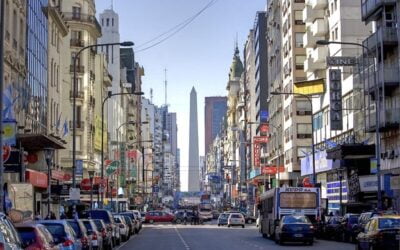Tallinn, Estonia’s capital, has become a magnet for digital nomads and entrepreneurs seeking a tech-savvy business environment. With its innovative e-government system and blockchain technology, the country has streamlined bureaucracy and made it easy for businesses to flourish.
Table of Contents
- 1 Geography
- 2 Visa application
- 3 Neighborhoods popular with digital nomads
- 4 The cost of living and arbitrage
- 5 Accommodation
- 6 Quality of life
- 7 Groceries
- 8 Best co-working spaces
- 9 Crypto community
- 10 Tech startups
- 11 Digital Nomad Community
- 12 Local nomad job opportunity
- 13 Popular recreational activities and fun spots
- 14 Transportation
- 15 Security/ safety
- 16 Cultural and social norms
- 17 Political and economic stability
- 18 Language and language barriers
- 19 Health
- 20 Internet
- 21 Telephone connectivity
- 22 Payment services and infrastructure
- 23 Climate and seasons
- 24 Cuisine
- 25 Tax requirements on digital nomads
- 26 Common concerns
In fact, the country boasts one of the highest concentrations of startups per capita in the world.
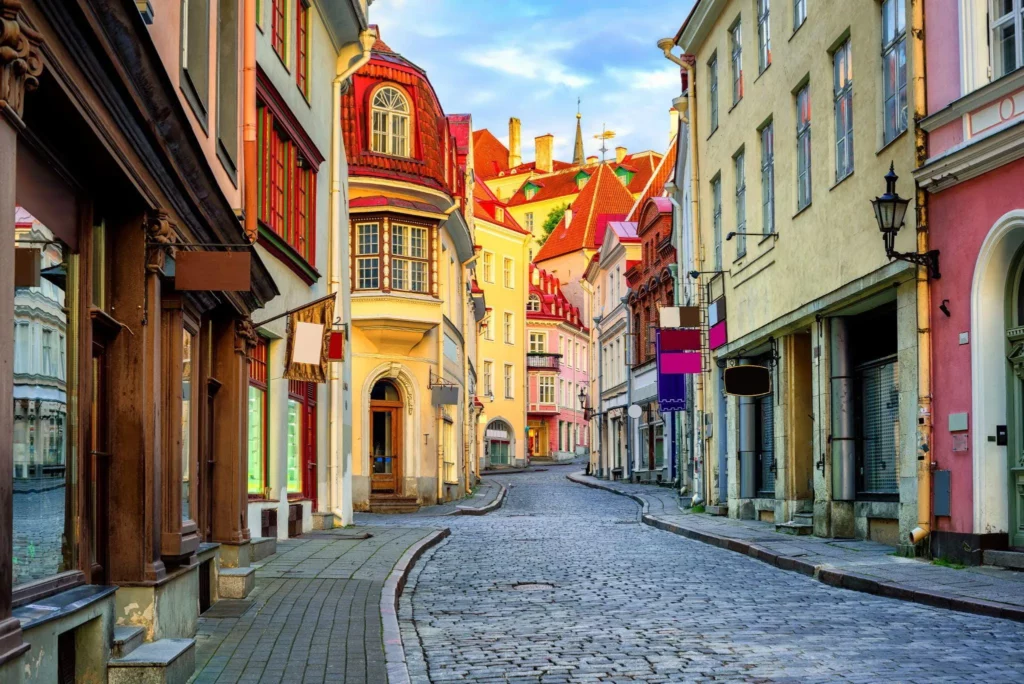
As Estonia’s financial and business center, Tallinn is home to over half of the country’s companies and generates 50+% of its GDP. The city is an ideal location for international enterprises and development centers.
Here are the critical aspects of this city:

In this guide, we’ll explore all the city offers as a great destination for digital nomads. So, let’s dive in!
Geography
Tallinn, Estonia is located on the Baltic Sea shores in Northern Europe. The country is in the Eastern European Time Zone (EET), meaning UTC+02:00 or +3:00 during summertime. Despite having a population of just 1.3 million, it’s larger than Denmark or Holland, with 45,300 square meters of land. Tallinn City has a population of 445,005 and covers an area of 159 square kilometers.
With its long and narrow shape stretching along the shoreline of the Gulf of Finland, Tallinn has plenty of space for peaceful walks, cycling paths, and avenues. It generally has a flattish landscape, and it’s sparsely populated like the rest of Estonia, with a population density of 30.4 people per square kilometer which is below the European average.
Visa application
Estonia is part of the Schengen Area and a member of the European Union, meaning many visitors won’t need a visa for entry. Here, we’ll explore the visa exemptions and requirements for digital nomads from different countries traveling to Tallinn.
Digital Nomad Visa

This visa lets you live in Estonia for one year and work remotely. To be eligible, you must have an employer or company registered abroad. Basically, you work as a freelancer with clients mostly outside Estonia.
The process of applying for the Digital Nomad Visa
Applying for a Digital Nomad Visa is a simple process that takes up to 30 days. To apply, visit the nearest Estonian Embassy and submit your application. Once approved, you can pick up your visa at the embassy. The Standard visa rules and procedures apply.
Requirements to qualify for a Digital Nomad Visa
To qualify for a Digital Nomad Visa, applicants must meet the following requirements:
- The ability to work remotely and independently from any location.
- An active employment contract from a company registered outside Estonia, conducting business through your company registered abroad, or working as a freelancer with clients mostly outside Estonia.
- Meet the minimum income threshold of €4,500 gross before tax six months before your application.
The required documents include the following:
- Proof that work can be performed using telecommunication technology.
- Proof of employment or business activities with a foreign-registered employer or company.
- Legal income documents for the past six months.
- A CV and description of job history and education.
You must provide various certificates and documents, including written confirmation from your employer, employment contracts or credentials of the company’s registration, and proof of payment of taxes and social security contributions.
The cost of the Digital Nomad Visa
When applying for a Digital Nomad Visa (DNV), you have the option to use a D-visa (extended stay) or a C-visa (short stay), depending on your intended length of stay. A D-visa fee is €100, while a C-visa costs €80. Children aged 6-11 pay a visa fee of €40, while children under six years are exempt from visa fees.
Visa-free entry for EU citizens
Estonia being a member of the European Economic Area and the European Union means that citizens of these countries can enter without a visa if they have valid ID cards. Also, family members of EU/EEA/EFTA (European Union/ European Economic Area/ European Free Trade Association) nationals who hold passports and residence cards issued under Directive 2004/38/EC can enter the country without a visa; provided they travel together with or to an EU/EEA/EFTA national.
Visa-free entry for citizens from Schengen Area
Citizens of the Schengen Area countries can also travel to Estonia without a visa. Estonia is a Schengen Area member.
Although your travel documents won’t be checked at internal Schengen borders, carry your travel documents (passports or national ID cards). Authorities like police or immigration officials have the right to inspect such travel documents if needed.
Short-term visa-free entry
Citizens of various third countries are allowed to enter the Schengen area, including Estonia, for stays of up to 90 total days within 180 days, without a visa.
Here are countries that are eligible for short-term visa-free entry:
| Passport Requirement | Country List |
| Biometrical passports holders | Ukraine, Montenegro, North Macedonia, Moldova, Bosnia and Herzegovina, Georgia, and Albania. |
| Biometrical passport holders but not passports by the Serbian Coordination Directorate (Koordinaciona Uprava) | Serbia |
| Passports with identity card numbers | Taiwan |
| All passports | Fifty-nine countries, including Argentina, the United States of America, Northern Ireland, the United Kingdom, and Venezuela. |
Citizens of third countries with special entry
Citizens of third countries holding diplomatic, service, or special passports are exempt from having a visa to enter Estonia for 90 days in 180 days.
This includes citizens from the following countries.
| Passport Type | Country List |
| Diplomatic passports | Armenia, Azerbaijan, Belize, Egypt, India, Jordan, Kazakhstan, Kuwait, Kyrgyzstan, People’s Republic of China, Suriname, Tajikistan, Tunisia, Turkmenistan, Uzbekistan, and Vietnam. |
| Diplomatic and service passports | Bolivia and Cabo Verde. |
| Diplomatic, special and service passports | Turkey |
| Diplomatic and official passports | Thailand, Philippines, and Morocco. |
| Biometric diplomatic passports | Belarus and Mongolia. |
| Suspended Diplomatic passports | Russia |
| Other | Holders of the Laissez-Passer from the UN. |
Difficulty in visa application
Obtaining a visa to Estonia can be challenging in certain situations. Visa applications can be refused on several grounds, including the inability to provide proof of your reason for visiting and preconditions of the stay, insufficient means of subsistence, and doubts about your intention to leave the territory before the expiry of your visa. An issued permit may also be revoked if the conditions for issuing it change.
Fortunately, you can appeal by submitting a written application within 30 days. The appeal processing fee is EUR 80. Therefore, carefully review the visa application requirements and ensure that you meet all the conditions before applying to avoid any difficulties in obtaining a visa.
Neighborhoods popular with digital nomads
Tallinn offers modern comforts, lively nightlife, and rich cultural experiences. As a digital nomad, you’ll find plenty of options for living and adventure in neighborhoods like the Old Town, Kalamaja, and Kadriorg.
Tallinn Old Town
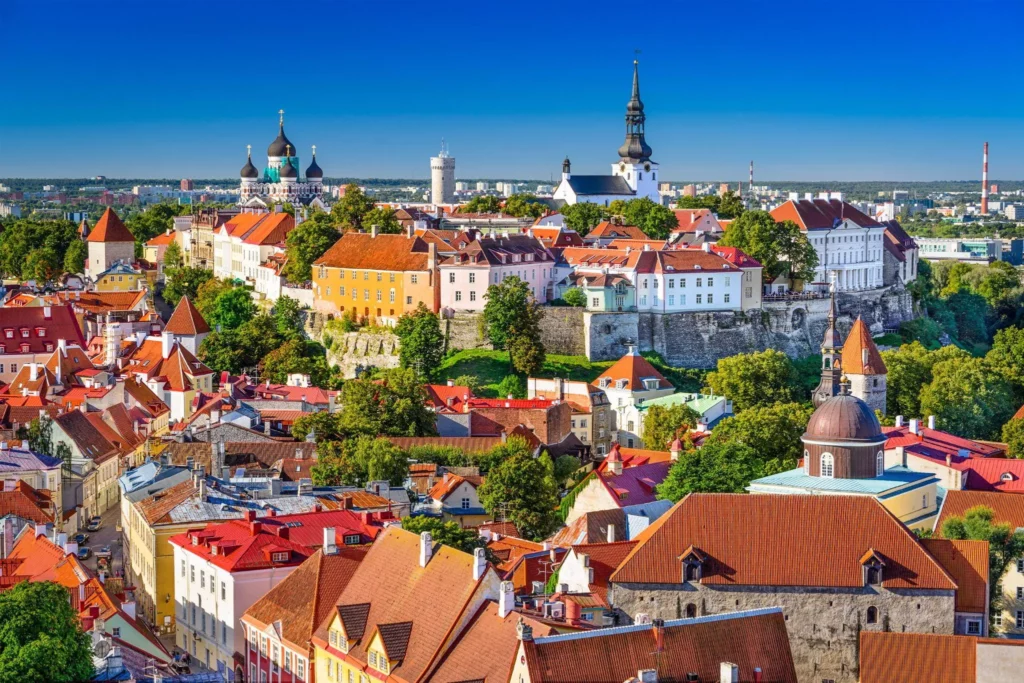
Tallinn Old Town is considered the best-preserved medieval city in Northern Europe, with winding cobblestone streets, Gothic spires, and enchanting architecture. Once home to wealthy merchants from Denmark, Germany, and beyond, it’s now a hub of museums, bars, restaurants, and galleries. And it provides plenty of opportunities for work and leisure.
The area’s exceptionally intact 13th-century city plan led to its UNESCO World Heritage Site designation in 1997. Visitors can explore original cobblestone streets lined with medieval churches and grandiose merchant houses, warehouses, and barns from the Middle Ages.
Kadriorg
This romantic inner-city area, located near the coast, is often considered the heart of Tallinn. It features Kadriorg Palace, which was established by Tsar Peter the Great. Its surrounding park features 18th-century architecture, fountains, and streams. The area also has historical wooden houses with detailed door frames and blooming trees.
Along with the charming local cafes and elegant restaurants, Kadriorg boasts a sophisticated art scene. Estonia’s most extensive art collection is exhibited in the Kadriorg Art Museum, KUMU Art Museum, and Adamson-Eric Museum. With its blend of history, culture, and natural beauty, Kadriorg is a must-visit neighborhood.
Kalamaja
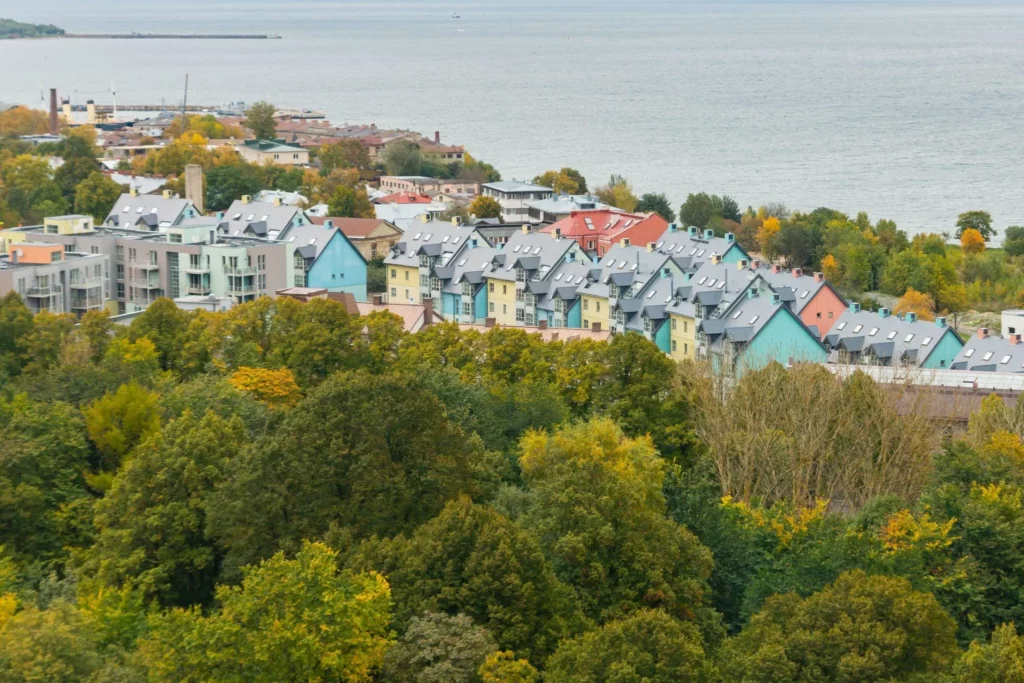
Kalamaja, a former industrial district, is now a creative hub of Tallinn, attracting young and creative visitors. Known for having colorful wooden houses, an industrial heritage, and a bohemian charm, Kalamaja is conveniently located between Tallinn’s scenic coast and Old Town. The district features preserved old factories, now used for cafes, restaurants, galleries, and even offices. The Patarei sea fortress and Seaplane Harbour Museum exemplify Kalamaja’s industrial heritage, while the Estonia piano factory still manufactures world-famous pianos on Kungla Street. Guided tours of Kalamaja are available for architecture and history enthusiasts, while individuals and families can enjoy the Energy Discovery Center, Seaplane Harbour Museum, and PROTO Invention Factory year-round.
Noblessner
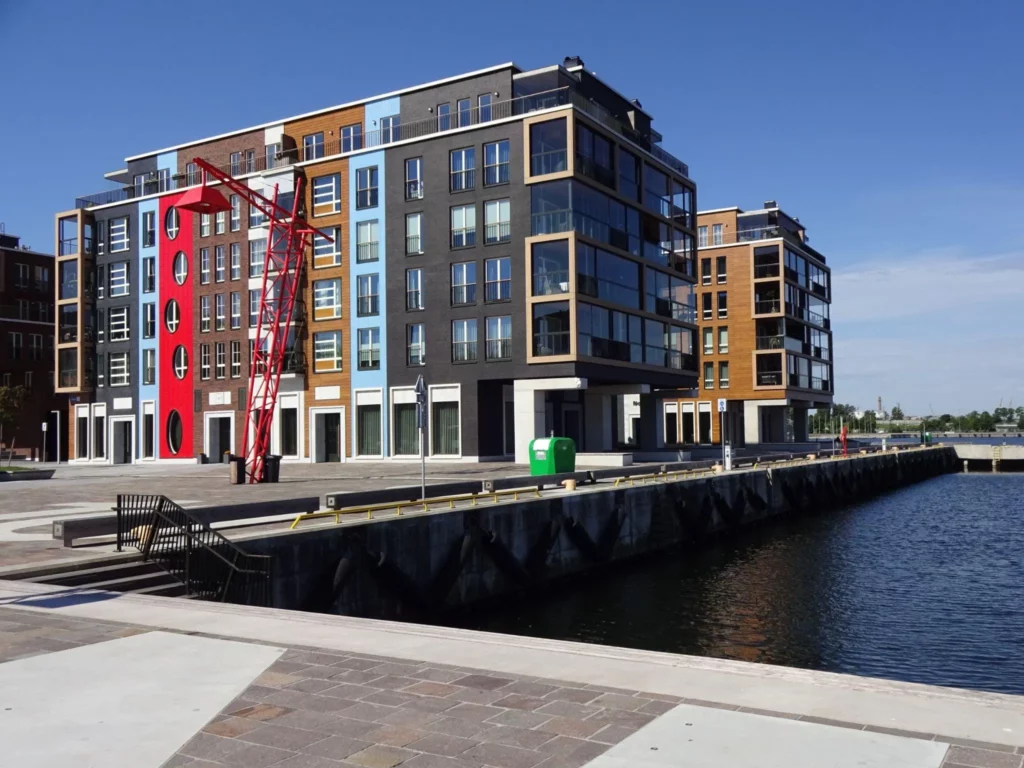
Noblessner, a former submarine factory, is now a thriving community of apartments, high-end restaurants, shops, and cultural venues. The sea is always present in Noblessner’s atmosphere since it’s on a picturesque harbor.
The history of Noblessner dates back to 1912, when two St. Petersburg businessmen developed the most vital submarine factory in then-Tsarist Russia. Twelve modern submarines were built here between 1913 and 1917, supplying the Russian Tsar’s navy. Shipbuilding and repair continued until 2018 when the area was finally opened to the public. Today, Noblessner has undergone rapid development and won the Best Urban Regeneration during the 2020 Baltic Real Estate Awards for its mix of historical buildings and modern architecture.
Here, you will find a yacht harbor, offices, and several cultural venues, such as the PROTO Invention Factory VR Centre, Kai Art Center, and techno nightclub HALL. Culinary highlights include the Lore Bistroo, a local favorite, and restaurant 180°, founded by Michelin-starred chef Matthias Diether. The Põhjala Brewery also has its factory and taproom in Noblessner.
The cost of living and arbitrage
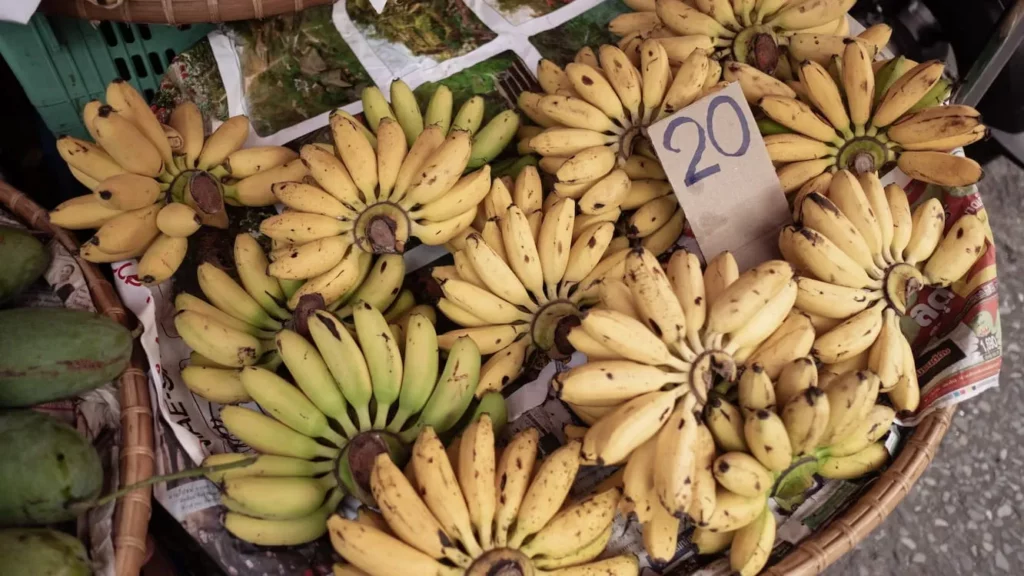
The capital of Estonia is an increasingly popular digital nomad destination for its high quality of life and affordable living costs. According to Numbeo’s cost of living comparison, Tallinn is significantly cheaper than London and New York City, two of the most prominent cities in the world. Compared with London, consumer prices are 27.9% lower in Tallinn (without rent), and rent prices are 73% lower. Additionally, restaurant prices are 31.7% lower, and grocery prices are 22.3% lower than in London.
Compared to New York City, Tallinn’s consumer prices are 39.6% lower (without rent), and rent prices are 81.1% lower. Restaurant prices in Tallinn are 37.5% lower, and grocery prices are 53.7% lower.
Numbeo’s cost of living index for Tallinn is 59.6, making it one of the most affordable cities in the world. The city ranks in the 244th position in the global cost of living index, and it’s significantly cheaper than cities like Zurich (3rd position), Geneva (9th position), and San Francisco (12th position).
Accommodation
Digital nomads seeking accommodation in Tallinn City may find the home rental market challenging due to its fragmented nature. The most popular way to find rental opportunities is through social media groups, as there are limited central places for rental information. Also, due to the recent influx of Ukrainian refugees, the availability of rental properties has decreased significantly.
The traditional renting process requires the first month’s rent, a deposit (1-3 months), and an agent fee equivalent to one month’s rent. However, new services like Rendin are making it easier for renters to start with much lower costs. Rendin is a home rental agreements platform with tenancy insurance, making it a deposit-free alternative.
If you prefer using real estate agencies, there’s a list of trusted estate agencies from the Estonian Association of Real Estate Companies. Alternatively, search for rental properties on real estate websites like city24.ee and KV.ee or real estate agency sites like Pindi and RE Kinnisvara. When you find the perfect house, consult real estate professionals to understand your lease agreement before signing.
Here are the typical rental prices to expect:
| Type of Accommodation | Rent per Month |
| 1-bedroom apartment in the city center | €659.43 |
| 1-bedroom apartment outside the city center | €478.15 |
| 3-bedroom apartment in the city center | €1,111.12 |
| 3-bedroom apartment outside the city center | €794.29 |
Co-living spaces

Scandium Living and Larsen are two major providers of co-living spaces in Tallinn for digital nomads looking for flexible, short-term accommodation.
Scandium Living offers studio apartments starting from €355 per month, while Larsen has studio apartments starting from €469 per month. Both providers offer a selection of apartments in different locations in Tallinn, and the apartments are fully furnished, with utilities and Internet included in the price.
Quality of life
Based on Numbeo’s Quality of Life Index, Estonia (ranked 18) offers a similar quality of life as the UK (ranked 21) and even the US (ranked 17). Tallinn, the capital city, offers a modern, hassle-free living and working environment. Moreover, Estonia is a digital society that provides a unique e-government system, allowing citizens to conduct nearly all their business online (from voting to signing documents and paying taxes). This has added transparency and efficiency to vital sectors like healthcare and education.
In the latest Nation Brands report, Brand Finance named Estonia’s digital infrastructure as the world’s fastest-growing nation brand in 2021. Estonia’s e-Residency Programme has contributed to the rapid growth of the national brand by allowing people worldwide to access the country’s public e-services and to establish their EU-based companies online.
Electricity, water, heating, cooling, and garbage
Essential utilities in Tallinn are relatively affordable, with electricity, cooling, heating, water, and garbage for an 85 m2 apartment costing approximately €269.61 per month.
The country has an open electricity market whereby residents can choose suppliers. The standard for electricity supply is 220 volts at 50 Hz, with a continental European two-pin plug used in homes. In contrast, natural gas comes from one supplier, Eesti Gaas, and agreements for gas payments can be made with your landlord or service provider. Each residence is served by the local water and sewage company for water supply, with a single supplier per address. Finally, for garbage, you’ll find public containers for free packaging waste disposal all over Estonia. Check for the nearest spots on the kuhuviia.ee map.
Here are crucial insights on the city’s utilities:
| Key Insights | Value |
| Municipal waste generated per resident per year | 480 kg |
| Public packaging waste collection centers | 290 |
| Municipal waste deposited in a landfill | 7.7% |
| Average daily water consumption per resident | 134.7 liters |
| Water supply from Lake Ülemiste | 88% |
| Housing connected to the public sewerage system | 99.9% |
| Housing connected to public water supply | 99.8% |
| Approach to treating city wastewater | Chemical and biological |
| The total length of water mains | 1,099 km |
| The entire length of sewage pipes | 1,044 km |
Groceries

Tallinn offers a variety of supermarkets to buy groceries. The major shopping centers, such as Ülemiste and Kristiine Keskus, are open daily from 10 am to 9 pm. For smaller shops, the opening hours are usually from 10 am to 7 pm on weekdays, from 10 am to 5 pm on Saturdays, and closed on Sundays and public holidays.
Here are the typical costs for a few grocery items:
| Grocery Item | Cost |
| Milk (1 liter) | €1.02 |
| White rice (1kg) | €1.90 |
| Fresh white bread (500g) | €1.12 |
| 12 Eggs | €2.33 |
| Chicken fillets (1kg) | €7.38 |
| Apples (1kg) | €1.56 |
| Beef round (1kg) | €13.27 |
Best co-working spaces

Tallinn has 13 prominent co-working spaces available for digital nomads. Regus is an excellent choice among the larger co-working operators, with 5 locations in Tallinn, 139 co-working desks, and 181 private offices. Regus provides flexible options, including office space, co-working, virtual offices, membership, and meeting rooms. Some key locations include Rotermann, Tornimae 5, and Metro Plaza. And the co-working membership options range from $89 per person for five days a month to $205 per person for a whole month.
Another great option is Workland, which has several locations across Tallinn, including Workland Vabaduse, which starts at €240 per month. Workland offers private offices, dedicated desks, hot desks, virtual offices, meeting rooms, and podcast rooms.
Crypto community

Estonia has a significant crypto community, with numerous crypto businesses and initiatives. Overall, the country’s crypto-friendly policies and active crypto community make it an attractive destination for digital nomads interested in cryptocurrencies.
Size of the local crypto community
Estonia has a population of 1.3 million, and roughly 20,013 people own crypto, according to a 2023 report, making up 1.51% of the population. Moreover, in 2021, the country hosted 55% of the world’s registered virtual asset providers. Multiple Estonian companies like Guardtime and Supplain are also utilizing Web3 technology for building next-gen products like medical records, protecting global forests, and improving supply chains.
The legal status of crypto
In 2017, amendments to the anti-money laundering legislation defined cryptocurrencies as digital assets and required service providers to have a license. The regulations apply to providers of services for exchanging virtual currency with fiat currency or virtual currency wallet services, among others. Furthermore, in 2019, the Estonian Financial Intelligence Unit (FIU) introduced additional regulations applicable to the cryptocurrency license process, including a licensing fee, a physical headquarters in Estonia, and identifying customers.
Recently, Estonia has tightened its regulations further. As of June 15th, 2022, Estonian crypto companies must meet new transparency requirements and can’t have anonymous accounts. They must also have a minimum capital of €250,000.
Crypto startups based in Estonia
Estonia is a pioneer in the crypto industry, being the first European country to issue crypto licenses in 2017. However, with the recent crackdown on crypto permits, over 1,000 activity licenses were withdrawn in 2020, leaving only around 400 virtual currency service companies active in Estonia.
Despite these new rules, the country still has thriving crypto startups. One such company is UnitEx, a licensed crypto exchange in Tallinn that launched in March 2021. The platform is registered according to existing regulations and has obtained a Virtual Currency Service Provider license from the National Financial Intelligence Unit RAB. Konsta Network and WhalesHeaven are also two notable crypto startups based in Tallinn. Konsta Network is a decentralized blockchain fully backward EVM compatible with a focus on security. WhalesHeaven offers peer-to-peer swaps that are non-custodial and cross-chain at six times cheaper than Uniswap.
Kompute OÜ is another startup based in Tallinn, developing software that enables a decentralized cloud computing network, connecting consumers of cloud services and computing providers.
Taxation on cryptocurrency
According to the ETCB (Estonian Tax and Customs Board), income received in cryptocurrency is taxed like income received in traditional currency. This includes gains from transferring property, employment, and business. Any revenue generated from a change in cryptocurrency’s price, payment for goods or services, computer data rental, cryptographic mining, or cryptocurrency received as wages is taxable.
However, there are instances where income received in cryptocurrency is not taxable. For example, suppose you donate cryptocurrency, buy cryptocurrency for a regular currency, transfer cryptocurrencies between your electronic wallets, or give cryptocurrency as a gift. In that case, no gain is received, and therefore, no income is generated. Taxable income using cryptocurrency, such as rent, interest, and business income, is subject to income tax. Note that providing cryptocurrency swaps, wallet services, mining, and platform services may incur value-added tax (VAT).
As for the taxation rates, the following applies to residents of Estonia, EEA or Switzerland (if insured for social benefits at home), treaty countries (if insured for social benefits at home), and third countries:
- Director’s fee: 20% Personal Income Tax (PIT) and 33% Social Tax (ST) for Estonians. Residents of EEA or Switzerland pay only 20% PIT and can get an A1 certificate to avoid Estonian ST. Residents of treaty countries pay 20% PIT and can present a certificate from their home tax authority to avoid Estonian ST. Residents of third countries pay 20% PIT and 33% ST.
- Salary: No PIT and ST payable in Estonia for residents of EEA or Switzerland, treaty countries, and third countries. Estonians pay 20% PIT and 33% ST with 1.6% Unemployment Contribution (UC) withheld by employers and 0.8% applied to the gross salary.
- Dividends: Estonians either don’t pay PIT and ST or pay 7% PIT if the Corporate Income Tax (CIT) is paid at a 14% reduced rate instead of 20%. The same applies to residents of EEA or Switzerland, treaty countries, and third countries.
Tech startups
Remarkably, Estonia has been making a name for itself in the tech startup world, with a record of the highest per capita number of tech unicorns. Estonian companies like TransferWise, Skype, and Bolt have achieved over $1 billion valuations. For digital nomads looking to tap into this vibrant tech scene, the country offers a wide range of resources and support for startups at any stage. Foreigners can register E-resident companies and apply for all the available programs.
Here is an overview of various business support programs:
- Grants like the Estonian Business and Innovation Agency and Prototron.
- Incubators & Accelerators like the Tehnopol’s Startup Incubator and Startup Wise Guys.
- Themed incubators like the Tallinn Creative Incubator and Buildit.
- Hackathons like the Garage48 and Tööstushäkk.
Digital Nomad Community
Estonia introduced one-year visas for freelancers in 2020, primarily targeting digital nomads. The scheme aimed to attract individuals who are interested in song festivals, medieval cities, and smoked eel. The country expected approximately 2,000 people to make use of this program.
Apart from the visa scheme, digital nomads can also engage with the e-residency community, which consists of nearly 100,000 freelancers, entrepreneurs, and digital nomads who establish and operate Estonian-registered companies online. To connect with others conducting business in Estonia, one can join the e-residents of Estonia Facebook group. Alternatively, individuals can reach out to the Estonian e-Resident International Chamber Association (EERICA).
Local nomad job opportunity
Digital nomads seeking local job opportunities would need an appropriate visa. Currently, CV-Online (CV.ee), CV Keskus, and Work in Estonia are the most famous Estonian job search portals.
Fortunately, there are also various tools available to find remote jobs worldwide, such as Nomad List, Upwork, Fiverr, and Toptal. Based on the current cost of living, Nomad List shows several remote job offers that could cover your expenses in Tallinn. They include;
Popular recreational activities and fun spots
Estonia’s capital is a unique mix of medieval and modern culture, making it a delightful destination for travelers of all interests. Tallinn’s Old Town, the best-preserved medieval city in Northern Europe, features medieval houses, alleyways, and many legends and stories. The city’s revamped districts (Noblessner, Telliskivi, or Rotermann) offer even more interesting architecture.
For those interested in cultural richness, there are plenty of museums to visit in Tallinn. A Museum Card pass allows unlimited visits to 500+ exhibitions and 100+ museums for an entire year at just €59.
Some of the main attractions in Tallinn include:
- Kadriorg Park
- Kumu Art Museum
- Bastion passages in the Old Town
- Tallinn TV Tower
- Telliskivi Loomelinnak
- St. Olaf’s Church Tower and Observation Platform
- Fotografiska Tallinn
In addition, Estonia boasts a nature reserve within 30 minutes of any location in the country, making it ideal for digital nomads who love to explore nature while working remotely.
Transportation
Estonia is conveniently located in Northeastern Europe, making it easily accessible from anywhere on the continent. Travelers can fly, sail, ride, or drive to the country. Bus services connect Tallinn to European capitals such as Warsaw and Berlin. Alternatively, an overnight train ride from Saint Petersburg leads to the heart of Tallinn. And Tallinn has an international airport close to the city center for those who prefer air travel. The ferry port is also near the city center.
A popular option to visit the city is a day trip from Helsinki. The ferry trip from Helsinki to Tallinn averages 2 hours either way.
Airlines
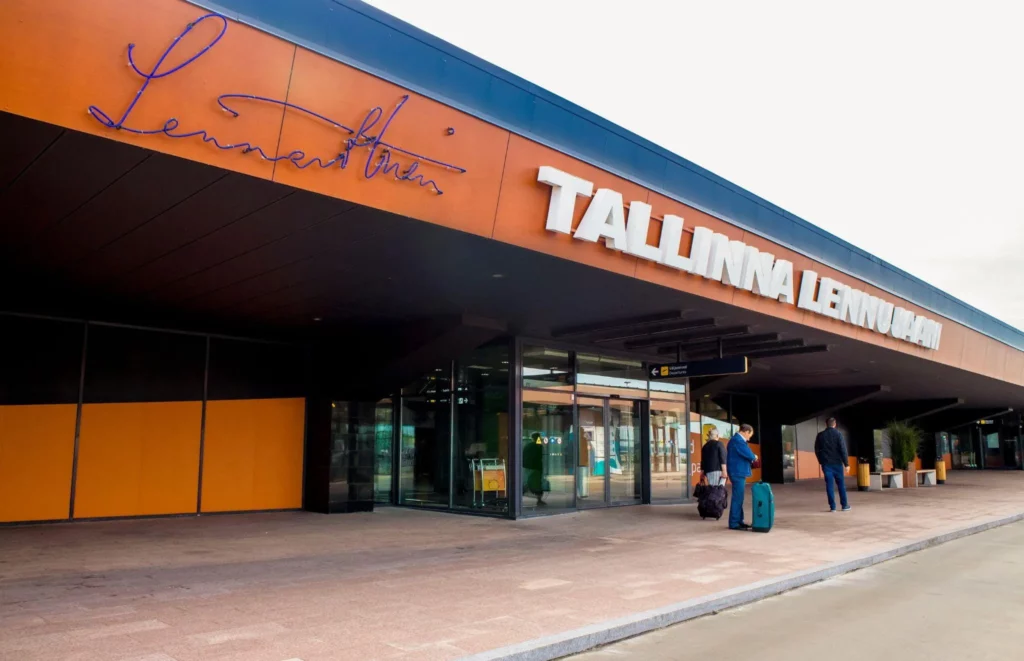
Tallinn has excellent airline facilities and services provided by Lennart Meri Tallinn Airport. The airport was awarded an Airport Service Quality award in 2023 and is one of only five airports globally to be inducted into ACI World’s Roll of Excellence. This airport hosts several airlines that operate regular flights to Tallinn, including Aegean Airlines, AirBaltic, Finnair, Lufthansa, Norwegian, Ryanair, SAS, SunExpress, Swiss, Turkish Airlines, and Wizz Air.
Once you reach the airport, you have several transportation options to get to the city center, including buses, trams, rental cars, and taxis. The bus stops are at the northern end of the passenger terminal. The airport’s buses, numbers 2 and 15, run a 20-minute ride from the airport to the city center. You can also purchase a single QR ticket (€1.50 for a single trip) or an Ühiskaart (Tallinn’s public transport card) on city buses.
Boat, ferry, or cruise ship

International cruise ships dock at the Port of Tallinn, 1.6 kilometers from the Old Town. Therefore, you can easily reach the Old Town on foot or by taxi. However, due to negative feedback, bicycle taxis or velotaxis are not recommended by the Tallinn City Tourist Office & Convention Bureau. If you must take one, ask the driver about the approximate cost and clarify whether it is per person or ride.
For those arriving from Helsinki, ships bring travelers to Tallinn’s passenger port daily. Yachts are also welcome. You can walk to the Old Town from the Port of Tallinn, which takes 15-20 minutes, depending on the terminal. Alternatively, buses 20 and 20A depart from Terminal D and take you to the city center. Purchase tickets using contactless payment cards on board for €2 or at ticket machines at the A and D terminals for €2. Taxis are also available, and the cost to the city center from different port terminals ranges from €7-€10.
Public transport
Public transport in the city has become increasingly popular, with nearly 96.3 million trips made in 2022, a 27% increase from 2021. Public transport services have been improved in several urban areas, including extending routes, adding additional departures on weekdays and weekends, and replacing regular buses with larger-capacity articulated models on streets with higher demand.
The city has 80 public transport lines, consisting of 72 bus lines, four tram lines, and four trolleybus lines; 47 trams, 441 buses, and 32 trolleybuses serve during rush hour. The city’s public transport service also uses 545 buses (350 are gas-powered and 44 hybrids), 44 trolleybuses, and 65 trams.
To use the public transport network, you can purchase an hour (€2), day (€5.50), three-day (€9), five-day (€11), or 30-day (€30) ticket or a Tallinn Card (ranges from €16-€64 and includes free entries to museums and sights). Tickets can be loaded onto an Ühiskaart (green plastic fare Smartcard) for a €2 deposit, which can be bought and reloaded online via the pilet.ee app or at numerous sales points in Tallinn.
Public transport services operate daily from 06:00 to 23:00. Each entry must be validated at the orange validators to avoid a €40 fine. Tallinn’s network of buses, trolleys, and trams make it easy to navigate the city and reach farther out destinations.
Tramlines and buses

The tram line starts from Tallinn airport. It takes only 15 minutes to get to the city center. And the capital can be accessed by international bus lines from several other European cities. Upon arriving at the Tallinn Central Bus Station, you can get to the city center by bus or tram. Bus routes number 17 and 23 have stops closest to the center.
The same tickets are used for city buses, trams, and trolleybuses.
Here are the rates for the Tallinn Card:
| Duration | Adult Price (€) | Child Price (€) |
| 24 hours | 34 | 20 |
| 48 hours | 51 | 26 |
| 72 hours | 62 | 32 |
Train
The railway station (Balti jaam) is located near the Old Town. To reach the city center, simply cross Toompuiestee Street on foot. Additionally, several bus and trolley lines operate from the railway station. Number 2 and 3 buses take you from the Balti Jaam bus stop to the city center. Numbers 21 and 21B go through the city center towards Rocca Al Mare.
Bicycle
The city’s City Bike bicycle rental offers a variety of 180+ bikes for hire, including trekking, mountain, city, and road bikes. Additionally, tandem and children’s bikes, bicycle trailers, and child seats are available. The rental price includes a reflective vest, helmet, bike chain, and extra equipment such as GPS devices, waterproof wheel bags, and first aid kits. City Bike also organizes biking trips lasting from one to several days. You get a 3-hour free bike rental with a Tallinn Card, while the ticket price is €8.00 for adults.
Tallinn has innovative bicycle racks with electronic locking systems and surveillance cameras if you want to park your bike. You can park free of charge using your Tallinn Smartcard or mobile phone. Find the bicycle racks on the bicycle routes map or the Bikeep app.
Taxis
Many taxi companies are available, and Bolt and Uber’s mobile apps provide easy ordering. Yellow stickers on the right side of the rear windows of each taxi display rates, which vary widely within allowed maximums. A ride from Tallinn airport to the city center costs about EUR 7, and from the harbor, about EUR 6.
Here are the typical taxi rates as listed on Numbeo:
| Taxi Ride Type | Rate |
| start (standard tariff) | €2.60 |
| 1 km ride (standard tariff) | €0.80 |
| 1-hour waiting (standard tariff) | €12.00 |
For those driving to Tallinn, the fastest road from or through Latvia is the Via Baltica (E67) highway. Roadside assistance is available 24/7 from Falck Autoabi OÜ. And the Estonian Road Administration’s online application, Tark Tee, is available in Russian, English, and Estonian for information on local road conditions and works.
Road safety and state of transport
Tallinn has relatively good highways connecting it to neighboring countries, but road conditions can vary significantly around the rest of the country. Moreover, drivers generally respect traffic laws, but country roads can be poorly lit, and animals may wander onto the road. Winter and spring can also bring hazardous driving conditions.
Public transportation is reliable, with buses and trains serving local connections around the main cities like Tallinn. Taxis are available, but only use officially marked ones and ensure that the meter is in use with prices visible. In 2019, Estonia had 3.9 road deaths per 100,000 population compared to the UK average of 2.6. Hence, visitors are advised to be cautious and aware of their surroundings when driving or using public transportation.
Security/ safety
As a digital nomad visiting Tallinn, you should take similar safety precautions as you would in Canada or similar major global nations. Crime levels in Tallinn are low, but pickpockets can be found in crowded areas. Therefore, keep your belongings with you and only drink in moderation. To report a crime, contact the emergency number 112 or submit a written report to the nearest police authority. Taking the necessary precautions will help ensure that you have a safe and enjoyable trip.
The crime rate, especially among expatriates
Tallinn is a safe city, but petty crimes such as pickpocketing and purse snatching are possible risks like all other destinations. This is especially so in the Old Town area and during peak tourist seasons. Thieves often operate in small groups and target travelers in public spaces like airports and train stations.
Fortunately, violent crime is rare, and foreigners are not the main targets. Instead, theft of vehicles or their contents is more common, and credit card or ATM fraud occurs frequently. Some young women may invite travelers in reputable bars to further socialize at nearby bars. Once in the new bars, travelers may fall victim to criminal activities or receive exorbitant bills. So, exercise caution and take sensible precautions to avoid falling victim to such crimes.
Dos and don’ts
Here are essential tips to help you stay safe during your visit to Tallinn City.
Dos:
- Carry the contact information for your nearest embassy or consulate.
- Follow local laws and social customs.
- Carry photocopies of passports and entry stamps, leaving the actual tickets securely in the hotel.
- Keep hotel doors locked and securely store valuables.
- Preferably, choose hotel rooms between the 2nd and 6th floors.
- Pay attention when using debit or credit cards.
- Use ATMs inside a bank or in well-lit public areas.
- Cover ATM keypads with one hand when typing your PIN.
- Confirm prices before ordering.
- Check for unauthorized transactions on your account statements.
- Don’t show off your wealth.
- Avoid poorly lit streets, parks, and certain areas after dark, like Kopli and Lasnamäe.
- Only carry a little cash.
- If card readers have unusual features, don’t use them.
- Make sure to leave your belongings in secure places.
By following those safety tips, you can enjoy Tallinn City with peace of mind.

Tallinn is rich in cultural and social traditions. Estonians love culture, particularly music and dance, which has been part of their identity for roughly one and a half centuries. It’s common for people to attend concerts, visit cultural sites and participate in amateur folk culture groups. Estonians are also reserved and prefer to keep to themselves in public places. They’ll walk fast, particularly in cold weather, but are welcoming and proud of their country. It’s a good idea to bring board games and have conversation topics to share with them.
Regarding mealtimes, lunch is usually served between 12 pm and 3 pm, with many restaurants offering special lunch deals on weekdays. Dinner is typically served between 6 pm and 8 pm.
Overall, respecting Estonian culture and traditions can help digital nomads have a more fulfilling experience.
How you might be expected to behave
When living in Tallinn City, knowing the local customs and how you’ll be expected to behave is essential. First, note that tipping is not compulsory, but leaving a 5% to 10% tip on the bill is typical if the service or your food is outstanding. Additionally, respect local customs and learn basic greetings, such as “Tere” for hello, and “Tänan” for thank you.
It’s also good to listen and observe during social activities, pay attention to cues, and be open to trying new things. Lastly, find mutual activities, topics, and interests with locals. Try inviting them for hangouts and show up to theirs, as it can take time to establish relationships. By being respectful, curious, and open-minded, you can have a rewarding cultural experience.
Cultural dos and don’ts
Here are some important cultural aspects to keep in mind.
Dos:
- Estonians value punctuality, so always be on time for your meetings or appointments.
- They love memes and sarcasm, so feel free to use them to break the ice and connect with them.
- Many Estonians are interested in learning about different cultures. Share your traditional food and customs to get closer to them.
- Learning Estonian and showing interest in the local language, culture, and customs will earn you respect.
- Don’t try too hard to impress. Instead, be yourself and avoid being two-faced. Estonians appreciate honesty and authenticity.
- Avoid being dramatic or over-sharing your problems. It may come off as unpleasant or problematic.
- Estonians have a dry sense of humor, so be patient if they don’t get your jokes immediately.
Local laws
Be aware of existing local laws and regulations to avoid legal problems. Here are some important ones to keep in mind:
- Illegal drugs: Use, possession, or trafficking of illicit drugs can result in severe penalties, including prison sentences or heavy fines.
- Reflectors (‘helkur’): Pedestrians are required by law to wear small reflectors on their clothing from dusk until dawn. These reflectors can be purchased at most stores.
- Drinking and Driving: Zero is the legal blood alcohol limit.
Being aware of local laws and regulations is essential to being a responsible digital nomad.
Political and economic stability
Estonia is a parliamentary republic with a stable political climate. According to the 2023 Freedom House report, the country is classified as a “Free” country (Global Freedom Score – 94/ 100) with high scores in both political rights (38/ 40) and civil liberties (56/ 60). In addition to its political stability, Estonia is known for its economic competitiveness. It’s the least corrupt and most transparent government in the Eastern and Central Europe region and ranks 13th out of 180 countries on the 2021 Corruption Perception Index. The Nation Brands report by Brand Finance shows that Estonia’s brand value rose 38% in 2021 from 2020, making it the fastest-growing national brand worldwide.
Estonia’s innovative e-governance and tax system makes it an attractive destination to work and live in.
The nature of politics and government
Tallinn serves as the capital city of Estonia. The City Government and City Council manage it. The City Council is the local authority’s representative body and is elected every four years. The council operates through plenary meetings and committees. On the other hand, the City Government (comprised of a mayor and six deputy mayors) manages institutions belonging to the city.
The city has eight administrative units or city districts, managed by district administrations. This city has a rich history going back to 3,500 years ago.
Tallinn’s city administration employs approximately 1,500 personnel in Tallinn government offices and about 19,500 employees in administrative institutions such as schools, kindergartens, and social houses. The city’s budget is about 1.032 billion Euros, and the current Mayor’s name is Mihhail Kõlvart, with the latest local government council elections held on October 17th, 2021.
Economic indicators
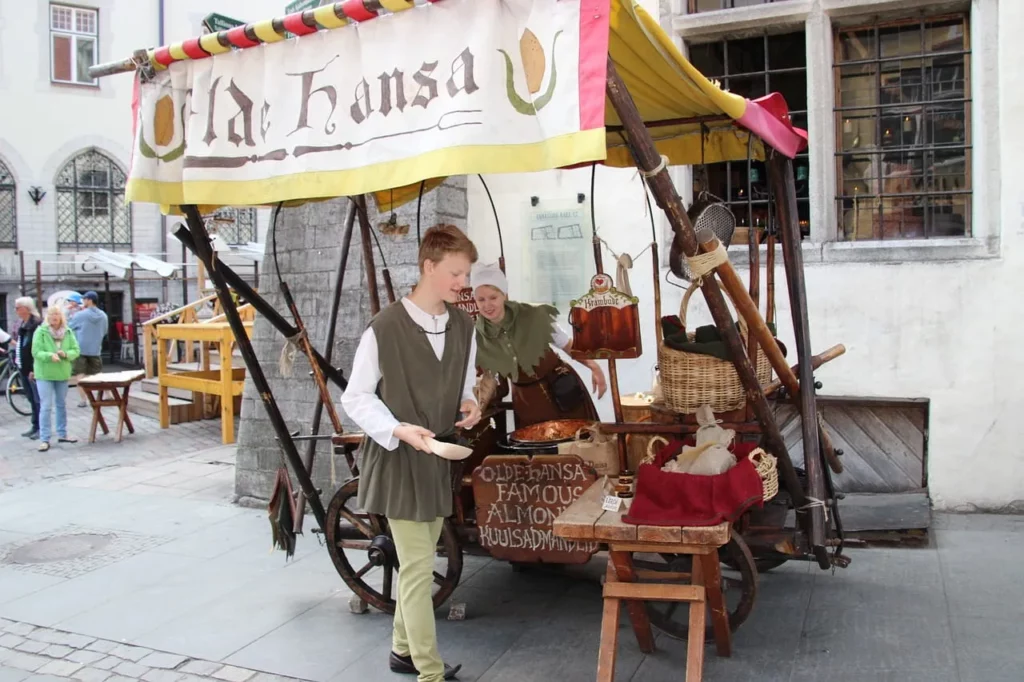
Tallinn City is Estonia’s important financial, business, and tourism center. Estonia’s overall economic status is evident in the fact that it’s a member of various international organizations such as the WTO, NATO, the European Union, the Schengen Area, the Organisation for Economic Co-operation and Development (OECD), and the Digital 5 cooperation network. Tallinn city also joined multiple international organizations like the Baltic Metropoles (Co-operation Network of the metropolises in the Baltic Sea Region), EACTV (European Association of City Televisions), ECM (European Cities Marketing), and EUROCITIES (Network of Major European Cities).
According to economic data, the city’s 2019 GDP per capita was €35,049.8. It attracted 1.97 million tourists in 2020. The labor force is approximately 250,000. And the Fitch Ratings is an AA–/stable rating.
Here are other key economic indicators:
| Economic Indicator | Value | Year |
| Annual change of consumer price index (CPI) | 19.40% | 2022 |
| Population growth rate | 1.95% | N/A |
| At-risk-of-poverty rate | 22.80% | 2021 |
| Absolute poverty rate | 1.40% | 2021 |
| Average monthly gross wages and salaries | 1,775 Euros | 2022 Q4 |
| Unemployment rate | 5.40% | 2022 Q4 |
| Employment rate | 69.60% | 2022 Q4 |
In conclusion, the city has a stable economy with diverse trading partners (mainly Finland, Germany, Sweden, and Russia).
Language and language barriers
Estonia’s official language is Estonian, a unique language belonging to the Finno-Ugric family. However, nearly everyone in Estonia speaks a foreign language, like English, Russian, Finnish, and German.
According to recent studies, Estonians are among the best English speakers in Europe; hence, getting around should be relatively easy for English speakers. Most locations in the tourist industry offer services in English, Russian, Finnish, and German.
Here’s a breakdown of the languages spoken based on the 2021 census:
| Language | Mother Tongue | Foreign Language | Total |
| Estonian | 67% | 17% | 84% |
| Russian | 29% | 38% | 67% |
| English | 0.3% | 47% | 47.3% |
| Finnish | 0.3% | 10% | 10.3% |
| German | 0.1% | 7% | 7.1% |
And here’s an overview showing the relatively wide range of ethnicities within Tallinn as of 2020:
| Ethnicity | Population | Percentage |
| Estonians | 234,195 | 52.80% |
| Russians | 164,662 | 37.10% |
| Ukrainians | 15,799 | 3.60% |
| Belarusians | 7,226 | 1.60% |
| Finns | 3,115 | 0.70% |
| Jews | 1,345 | 0.30% |
| Tatars | 1,235 | 0.30% |
| Latvians | 1,232 | 0.30% |
| Germans | 1,141 | 0.30% |
| Lithuanians | 1,103 | 0.20% |
| Armenians | 1,087 | 0.20% |
| Poles | 917 | 0.20% |
| Azerbaijanis | 782 | 0.20% |
| Other | 10,087 | 2.30% |
Health
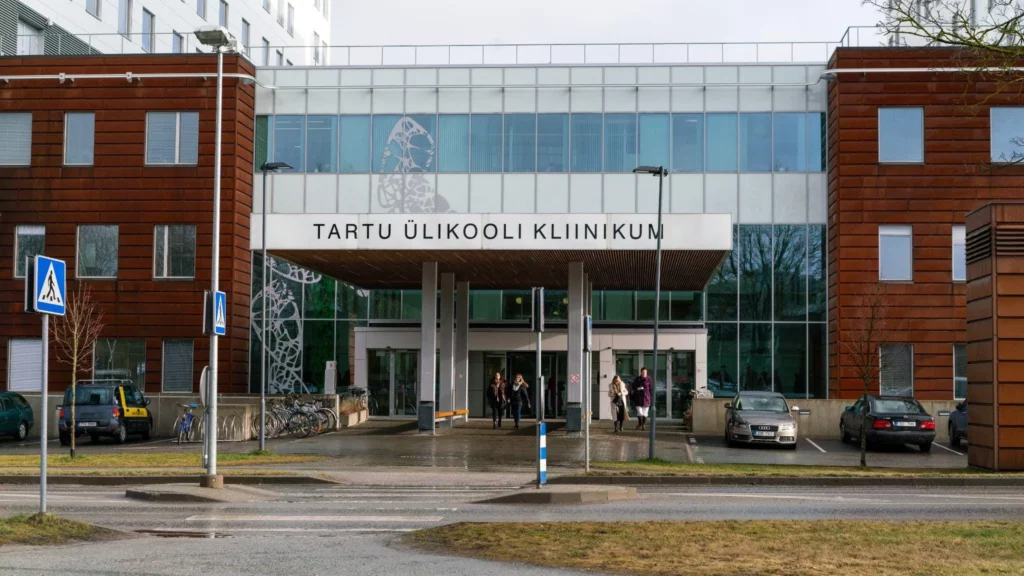
Tartu and Tallinn are two cities in Estonia with excellent healthcare facilities comparable to Canadian standards and other similar countries. However, the quality of care may vary throughout the country. You must have travel insurance.
The Estonian Health Insurance Fund, the Ministry of Social Affairs with its agencies, and independent health provider units are the main actors in Estonia’s health system. The Ministry of Social Affairs develops national health policies and legislation, registers health professionals, and licenses facilities. On the other hand, the Estonian Health Insurance Fund (EHIF) operates a national, mandatory health insurance scheme covering about 95% of the country’s population. This way, the Estonian healthcare system benefits from regulated cost control, ensuring that healthcare services are affordable and accessible.
Common infectious diseases
When traveling to Tallinn or any other city, you should be aware of any risks of contracting infectious diseases during your stay. Therefore, note that COVID-19 remains a risk in Estonia, so visitors must follow all necessary precautions. Tick-borne encephalitis or other tick-borne diseases may be prevalent in forested areas, and ticks commonly appear from March to November.
Additionally, infectious diseases like lower respiratory diseases and diarrhea are prevalent in the country, comprising over 62% of all fatal contagious diseases. Tuberculosis also poses a threat. Moreover, visitors should be wary and take precautions against other not-so-common diseases like Typhoid Fever, Hepatitis A, Hepatitis E, Dengue Fever, Malaria, and Rabies.
You can minimize the risk of contracting infectious diseases with proper precautions and awareness.
How to protect yourself from common diseases
You can protect yourself from common diseases prevalent in Estonia. Since COVID-19 remains a risk, practice good hygiene and stay home if unwell. If you have any symptoms of COVID-19, self-quarantine and seek medical advice from the Estonian Health Board. In case of acute symptoms, call for an ambulance.
Tick-borne diseases are common in forested areas; therefore, use insect repellent and wear long, loose, light-colored clothing. After visiting these areas, check for ticks and ensure that you remove the whole tick. Also, check the skin area for any signs of infection.
Food and water safety

According to the CDC, food and water standards in this country are similar to standards in the United States. So, most travelers do not need special precautions apart from what they usually do. However, waterborne and foodborne diseases might occur. Therefore, the Australian government’s Smart Traveller website recommends drinking boiled water or bottled water with sealed lids, avoiding ice cubes, not eating uncooked or undercooked food like salads, and avoiding contact with unknown dogs or other mammals. Even so, tap water is generally clean and safe to drink in Tallinn.
Air and noise quality
Estonia boasts excellent air and noise quality for a healthy and peaceful environment. With over half of the country covered by forested land and nearly a quarter being protected nature, the country ranks fourth for air quality worldwide. Estonia’s lush greenery is crucial in maintaining its clean air. According to 2020 data, the European Union’s limits on CO and SO2 have not been exceeded in Tallinn in ten years. Moreover, 66% of Tallinn residents reside within 300 meters of quiet spaces (spaces designed primarily for recreational purposes).
Clinics and hospitals
In Estonia, all healthcare providers operate independently under private law. The first level of contact is family physicians owned by local municipalities or family doctors and serving no more than 2,000 patients. The country has about 800 family physician practices, with a growing trend towards group practices, which only make up 30%.
Hospitals and outpatient centers provide secondary and tertiary care. Most hospitals are limited liability companies run by local governments or foundations run by municipalities, the state, or public agencies. Estonia has about 65 private and public hospitals (35 are nursing and rehabilitation hospitals). The Estonian Health Insurance Fund contracts 19 public hospitals in the Hospital Network Development Plan (HNDP).
In Tallinn City, here are several clinics and hospitals that digital nomads can visit:
- The AS Ida-Tallinn Central Hospital, located at Ravi tn 18, offers various services, including radiology and surgery.
- The AS Lääne-Tallinn Keskhaigla, located at Paldiski mnt 68, offers outpatient specialist care, dental care, surgery, and other services.
- The SA Northern Estonian Regional Hospital at J. Sütiste tee 19 offers medical services in all specialist fields except for obstetrics and ophthalmology.
Costs might vary for different facilities. For instance, a paid appointment with specialist doctors costs €45 at the AS Lääne-Tallinn Keskhaigla hospital.
Pharmacies and medicinal drugs
When traveling to and leaving Tallinn, it’s good to know that you can carry medicinal drugs for personal use. However, depending on the amount held, the specific medicine, and your destination country, you may need a permit. This permit verifies that your physician prescribed the medications, you bought them from an authorized pharmacy, and you did not involve any illegal trade.
You can also buy your medication locally from pharmacies that usually open from 10:00-19:00, with some staying open all night. The City Centre and Lasnamägi branches of Südameapteek are available 24/7. In shopping centers, pharmacies usually open from 9:00-21:00.
Health insurance
Before traveling to Estonia, digital nomads should purchase travel insurance. If you are a European resident, it is also worth checking if your healthcare provider has an existing contract with the Estonian Health Insurance Fund. Then get a free European Health Insurance Card (EHIC). While the EHIC is not a substitute for travel insurance, it entitles you to state-provided medical treatment like Estonian nationals, based on the European Parliament and Council Regulation No 987/2009. That means, in case of an emergency, you’ll receive emergency care with a visitation fee of only up to EUR 5.
Health care quality
Estonia has made impressive progress in health care over the past two decades, as seen in its rising life expectancy higher than other EU countries. Plus, the 2019 fertility rate stands at 1.7, compared to the EU average of 1.5. However, the COVID-19 pandemic resulted in a slight decrease in life expectancy in 2020. Also, Estonia spends less on health care per capita (EUR 1,733) than the EU average by half. Three-quarters of the health spending comes from public healthcare and one-quarter from out-of-pocket payments.
Behavioral risk factors, like smoking and alcohol consumption, continue to be a significant concern, causing about two-fifths of deaths. Overweight and obesity are also growing problems: more than one in five adults is obese.
Vaccination

As of June 18th, 2022, Estonia no longer requires a COVID certificate for travelers. However, it would be best to be up-to-date with all routine vaccines. These routine vaccines include Chickenpox, Flu, Diphtheria-Tetanus-Pertussis, Polio, Measles-Mumps-Rubella (MMR), and Shingles.
In addition to routine vaccines, the CDC recommends that unvaccinated travelers to Estonia receive the hepatitis A and B vaccines, among other vaccines for specific cases. Consult a healthcare provider to ensure you receive all necessary vaccinations before your trip.
Internet

Estonia ranks as a global leader in the digitalization of public services. It ranked 9th out of 27 other EU Member States in the DESI digital economy index in 2022. Almost 90% of the country’s internet users have access to e-Government services.
In Tallinn, you’ll find public Wi-Fi in nearly every restaurant, café, hotel, hostel, city square, park, and other open spaces. Even trams offer Wi-Fi, so you easily stay connected while exploring the city.
Here are the typical Internet speeds within the city:
| Type | Median Download Speed | Median Upload Speed | Median Latency | Providers |
| Mobile Internet | 77.88 Mbps | 16.42 Mbps | 19 ms | Elisa, Tele2, Telia (fastest) |
| Fixed Internet | 83.13 Mbps | 52.22 Mbps | 4 ms | Elisa (fastest), Infonet, Tele2, Telia (second fastest) |
Telephone connectivity
Estonia’s 4G coverage reaches 99.9% of the country. As a digitally advanced country, Estonia has one of the highest per capita numbers of cell phones. You’ll likely need to buy a local SIM card upon arrival.
How to register for a SIM card
You’ll get pre-paid SIM cards in all major shops, costing less than 5 Euros for one week of Internet. You can also buy SIM cards at the airport in Kiosk stores, gas stations, provider stores, R-kiosks, and post offices. Elisa, Telia, and Tele2 are the three major providers. All providers offer reasonably priced services.
Mobile phone plans and cost
Here is a sample of the mobile plans offered by the two major providers in Estonia (Telia and Elisa).
Telia’s 5G mobile plans:
- 5G – Unlimited: €35/month for unlimited calls and SMS in the Baltics and Scandinavia, and 27.8 GB (in the EU).
- 5G – 40 GB: €31/month for unlimited calls and SMS in the Baltics and Scandinavia, and 24.1 GB (in the EU).
- 5G – 20 GB: €29/month for unlimited calls and SMS in the Baltics and Scandinavia, and 20 GB (in the EU).
- 10 GB: €24/month for unlimited calls and SMS in the Baltics and Scandinavia, and 10 GB (in the EU).
- Basic: €3/month for unlimited calls within Elisa and 3 hours of calls to Telia and Tele2.
- Standard: €6/month for unlimited calls within Elisa, 6 hours of calls to Telia and Tele2, 100 SMS, and 1 GB of data.
- Premium: €9/month for unlimited calls within Elisa, 9 hours of calls to Telia and Tele2, 1 hour of calls to EU and Russia, 100 SMS, and 5 GB data.
- Perfect: €15/month for unlimited calls within Elisa, 10 hours of calls to Telia and Tele2, 1 hour of calls to EU and Russia, 600 SMS, and 15 GB data.
Emergency numbers and important contacts
Here are some emergency numbers and key contacts that digital nomads might find helpful in Tallinn:
- Estonia’s country calling code: +372
- Tallinn Tourist Information Centre: Located at Niguliste 2, 10146 Tallinn, Estonia or call +372 645 7777.
- Emergency number: 112
- Tallinn Helpline: 14410
- Estonian Police and Border Guard customer information: 612 3000
- Municipal Police Department dispatch number: 14410
- Rescue service information line: 1524
- Poison hotline: 16662
Payment services and infrastructure
The Bank of Estonia, also known as “Eesti Pank,” is the central bank responsible for defining and implementing the monetary policies of the European Central Bank. The Eesti Pank also supervises financial stability, manages Estonia’s official foreign exchange reserves, and maintains reliable payment systems and cash circulation. Notably, Estonia’s Payment Service Provider (PSP) community featured among the first in adhering to the Single Euro Payments Area’s (SEPA) Instant Credit Transfer (SCT Inst) in 2017. Generally, Estonians are known for their digital payment literacy and broad acceptance or use of cards without any minimum thresholds. Here, online banking began in 1996, mobile banking in 2000, and electronic identification and e-signatures in 2002, with Smartphones following in 2010. While NFC cards were slow to arrive, they are now rapidly becoming widespread. This well-developed payment infrastructure means using cards and digital payments is easy and convenient.
Popular domestic payment services
The most common retail payment option in Estonia is card payments. Larger stores, hotels, and restaurants accept Eurocard, MasterCard, Visa, and American Express credit and debit cards. Nets Estonia and Swedbank are responsible for processing card payments within the country, while international card payment organizations make international card payments.
In addition, carry some cash with you as smaller shops and markets may not accept cards.
Here is an overview of the top e-commerce payment methods within the country in 2022:

And the local credit institutions include (2020 data):
- AS Inbank
- AS SEB Pank
- AS LHV Pank
- AS TBB Pank
- Coop Pank AS
- Luminor Bank AS
- Bigbank AS
- Holm Bank AS
- Swedbank AS
Accessible international payment services
Accessible international payment services are essential for digital nomads. Fortunately, Estonia has a highly developed electronic payment system, and 99+% of bank payments go through electronic channels. Additionally, roughly half of Estonia’s card payments are contactless, with a limit of €50.
The top online payment methods include:
- Credit cards (e.g. Visa, MasterCard, American Express)
- Pay-by-Links (bank transfers through the payer’s Internet banking environment)
- PayPal
- SEPA Credit Transfer (regular bank transfers)
- SEPA Direct Debit
- Others (e.g. paysafecard, Bitcoin, Wise)
The country also has several branches of foreign credit institutions, including (2020 data):
- Citadele banka
- Folkefinans AS
- Nordea Bank Abp
- OP Corporate Bank plc
- Svenska Handelsbanken AB
- TF Bank AB (publ.)
Currencies and exchange rates
The national currency is the Euro. You can exchange your cash at currency exchanges such as Tavid, Monex, and Eurex or at banks like Swedbank, SEB, and Luminor. Both currency exchanges and banks charge service fees.
If you carry €10,000 or more, you must declare it to customs when entering or leaving the European Union. This includes banknotes and coins, negotiable instruments (cheques, promissory notes, travelers’ cheques, and money orders), bonds or shares, gold coins (90+% gold), gold nuggets, bars or clumps (99.5+% gold), and other convertible assets.
Climate and seasons

Tallinn experiences extreme differences between seasons in terms of weather and daylight. The Atlantic Ocean, the Gulf of Finland, the Baltic Sea, the East European Plain, and the Estonian mainland influence the climate, resulting in unpredictable or unseasonal weather throughout the year. Between November and March, winter brings cold temperatures and heavy snowfall.
Spring runs between March and May, and flooding may occur. On the other hand, summer offers a more favorable climate, with average temperatures ranging from 20.9°C in July, the hottest month, to occasional temperatures above 30°C. June 21st marks the year’s longest day, giving 19 total daylight hours.
Cuisine

Estonian cuisine is a delectable blend of traditional and contemporary flavors. Start your day with rye bread with creamy butter or some freshly picked berries. The cuisine is based on fresh, seasonal, and locally sourced ingredients. Tallinn’s evolving restaurant scene is a testament to this.
The city is home to young, ambitious chefs who redefine local cuisine by adding new twists to traditional dishes. Michelin-starred restaurants, such as NOA Chef’s Hall and Restaurant 180° by Matthias Diether, offer creative menus focusing on complementary flavors and textures. Apart from the renowned restaurants, the White Guide has also recommended several restaurants and cafes, including Kaja Pizza Köök, Viru Burger x VOLTA Restaurant, Pancake Counter Kooker, and Bakery Karjase Sai.
Tax requirements on digital nomads
You’ll be glad that Estonia ranks #1 in the 2022 International Tax Competitiveness Index, with an overall score of 100. The country offers a supportive tax system for small businesses, charging 0% taxes on annual incomes and reinvested profits. Additionally, declaring and paying taxes is 100% online through the e-MTA portal.
For digital nomads, here’s what you need to know about your tax requirements (for residents of EEA or Switzerland (if insured for social benefits at home), treaty countries (if insured for social benefits at home), and third countries):
| Income Type | A resident of EEA or Switzerland | A resident of Treaty Countries | A resident of Third Countries |
| Director’s fee | 20% PIT (Personal Income Tax) and no ST (Social Tax) with an A1 certificate. | 20% PIT and no ST with an A1 certificate. | 20% PIT and 33% ST. |
| Salary | No PIT and No ST | No PIT and No ST | No PIT and No ST |
| Dividends | No PIT and No ST or 7% PIT if CIT (Corporate Income Tax) paid at a 14% reduced rate | No PIT and No ST or 7% PIT if CIT paid at a 14% reduced rate | No PIT and No ST or 7% PIT if CIT paid at a 14% reduced rate |
Regarding double taxation treaties, Estonia signed 64 treaties (62 are in effect) to avoid double taxation, which includes most OECD and all EU countries. Besides, visitors from outside the EU can buy items without VAT from stores that offer tax-free shopping in Tallinn City. Check for a Global Blue Tax-Free Shopping window signage. The minimum amount is €38.01.
Disclaimer: The following information regarding tax requirements on digital nomads is provided for general informational purposes only. It should not be considered as legal, financial, or tax advice.
Common concerns
Although Tallinn is a tech-savvy and innovative city, there are a few concerns that digital nomads may have. One problem is that Estonian, the official language, is primarily only spoken in the country. Fortunately, many Estonians are fluent in English. Another issue is the climate, as Tallinn experiences long, dark winters with very little daylight. You may need to invest in proper winter clothing.
Despite the common concerns, many positive aspects make the city attractive for remote workers. First and foremost, Tallinn is known for its highly developed digital infrastructure and technological innovation, making it ideal for digital nomads who rely heavily on technology for their work. Additionally, the city offers a supportive environment for digital nomads, expats, and locals passionate about entrepreneurship and innovation. Furthermore, Tallinn is renowned for its rich history and culture, with a well-preserved medieval Old Town and a thriving arts and music scene. Finally, the city offers plenty of cafes, restaurants, and bars to enjoy the company of others.
Always check with local country websites for the most up to date visa, health, tax and travel requirements before entering a country. This article is general information and does not constitute legal advice, check with a legal professional for visas, working visas, applicable tax and crypto laws specific to you.

